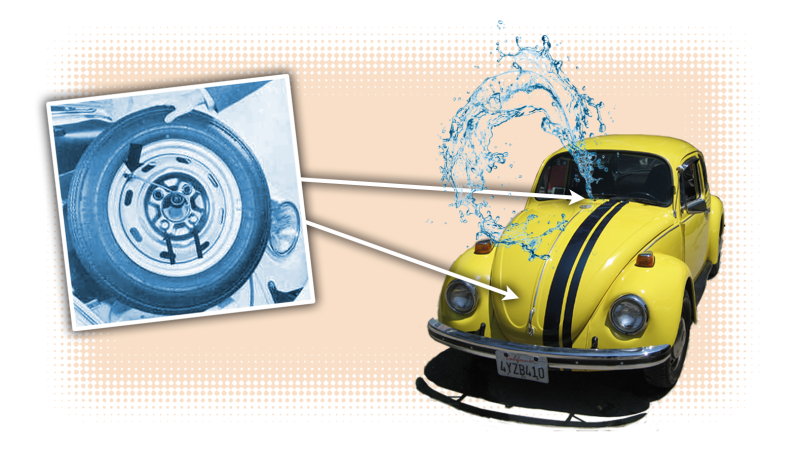
As a painful-to-be-around hardcore old air-cooled Volkswagen geek, I sometimes forget that the arcane details and quirks of these old cars are not necessarily common knowledge to everyone. That’s why I was actually surprised to find that some of my colleagues—equally hardcore gearheads though they are—didn’t know the goofy yet wonderful method old Volkswagens used to wash their windshields. On the off chance that you don’t know either, I’d be delighted to tell you all about it. So prepare yourselves.
Let’s start by just reminding ourselves exactly what a car’s windshield washer is and does. The job of the windshield washer system in most cars can be, if you’re a clever enough student of language, discerned by the name: it washes the windshield. It’s a complex, subtle thing, but I think you get it.
The way this usually happens is via the expulsion of a cleaning fluid, like water or some Windexian compound, onto the surface of the windshield, and then the windshield wipers wipe it all over the, um, windshield. It’s the part that involves the spraying of the fluid that I want to focus on.
To spray fluids with some force out of a little nozzle, you need either a muscular bladder like, say, your dog uses or, more suitable for a car, a pump of some kind. In most cars, this pump is a 12 volt electric pump that pressurizes the washer fluid tank so when the valve opens on the washer nozzle, out sprays the fluid.
Advertisement
Now, when Volkswagen decided to put a windshield washer on the Beetle back in 1961, they were sure of one thing: there was no way in hell they were going to install some decadent, fancy-ass 12V pump to squirt that fluid on the windshield.
Hell, they wouldn’t even spring for two separate bulbs for the in-dash turn indicator blinker arrows—they sure as shit weren’t going to just throw some expensive pump on there.
Advertisement
So, the first version used a little hand pump on the knob itself that required the driver to, by hand, pressurize the fluid tank, like some sort of filthy animal.
While it pretty much worked, there’s just something undignified about having to use your own muscles to pump water onto your windshield to clean it. People wanted something that did the pumping for you, since, you know, even in the 1960s hand-pumping felt sort of archaic.
So, the next year, Volkswagen figured out a way to automatically pressurize that fluid reservoir so all you had to do was push a button and that blue ejecta of cleanliness would spatter happily all over that windshield. And they did it without installing any electric pumps at all. How did they do it?
Advertisement
Cleverly, is how. Old VW windshield washers work by using the air pressure of the spare tire.
Yes, the spare tire! Personally, I think this is one of the most clever hacks in all of motoring. 99% of that spare tire’s life it’s doing nothing but taking up room i your trunk. VW put that tire to work, providing pressure to clean your windshield for, essentially, free.
Advertisement
The way it worked was this: a normal-looking windshield washer reservoir is mounted behind (or, later, in the middle of) the spare tire, and it has two hoses connected to it. One hose is long, and leads directly to the little frog-like washer nozzle on the cowl in front of the windshield. The other connects, via a special valve, to the valve stem of your spare tire.
You’d just over-inflate your spare tire to 43 PSI, and the special valve in the washer fluid bottle’s cap would prevent the tire from getting below 26 PSI, the amount you’d need to have to use the tire. That way, you can never totally flatten the spare even if you’re the most obsessive windshield washer.
Sure, every so often you’d notice that the once powerful ejaculation of washer fluid had degraded to a sad ooze, which just meant that the next time you got gas you’d inflate your spare tire back up to 43 PSI or so. Really, checking on the condition of your spare is never a bad idea, and you could always get a sense of how it was just by cleaning your window.
Advertisement
Volkswagen used this spare tire-driven washer system on the Type Is (Beetles, Ghias, Things, etc.) and Type 3s (Squarebacks, Fastbacks, etc.), but not the Type 2 buses, which had you just pressurize the reservoir directly with an air pump. And even though Type 4s were VW’s “premium” car, they still couldn’t bring themselves to include a real electric pump, even though VW wanted to sell them to kings and sheiks, probably.
Advertisement
This system has always been one of my favorite technical details about air-cooled Volkswagens. It’s clever, sure, but it’s also a little bit weird and even sort of obsessive, especially in its context on a car like the Type 4, which was much more expensive than an bargain-basement Beetle and certainly could have had an electric pump.
It’s like Volkswagen of that era was just so taken with the idea of wasting nothing, not even dormant air in a spare tire, that they simply could not in good conscience install a wasteful, decadent pump. Their system effectively got work done for free, and there’s a strange beauty there.
Of course, it’s worth mentioning that it often didn’t work that great, if we’re honest, and because the button on the dash knob wasn’t an electric switch but a valve to open or close the flow of pressurized fluid, it was possible to develop a leak behind the switch and inside the car, dripping down the rear of the dash, which was no fun.
Advertisement
Still, none of that pesky reality can cool my ardor for this idiosyncratic little bit of engineering. Put those lazy spare tires to work cleaning windows!















